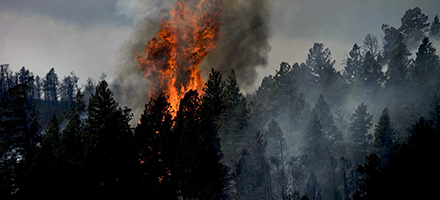 “The world is ablaze. Or so it seems, and the scenario is repeating itself every year now,” according to Dr François-Nicolas Robinne, of the University of Alberta’s Department of Renewable Resources, and Coordinator of IUFRO’s Fires: Economic Drivers of Global Wildland Fire Activity Task Force (TF). Source: Timberbiz
“The world is ablaze. Or so it seems, and the scenario is repeating itself every year now,” according to Dr François-Nicolas Robinne, of the University of Alberta’s Department of Renewable Resources, and Coordinator of IUFRO’s Fires: Economic Drivers of Global Wildland Fire Activity Task Force (TF). Source: Timberbiz
“So far in 2020, the Western USA has been burning out of control, with California experiencing its largest fire in recorded history; over 20% of the Pantanal, one of the most biodiverse wetlands in the world, has gone up in smoke in Brazil; and record-breaking temperatures in Siberia have been driving massive fires far above the Arctic circle, thereby releasing megatons of carbon into the atmosphere.
“Climate change,” he says, “is an obvious and legitimate culprit for wildfires,” and along with lightning strikes and other more naturally occurring fire drivers, bring challenges that must be addressed. “But many other drivers influence fires, and economic ones are often overlooked.
“The majority of global fire activity is human-caused and often linked to land degradation for the production of goods traded on the international market.
“The reality is that, in many parts of the world, fire activity and its aftermath can be linked to economic forces: the trade market, subsidies, insurance premiums, taxes, or something as simple – yet critical – as daily subsistence.”
His TF is looking into the nexus between the economic level of local populations, fire activity and effects on the provision of ecosystem services and the global appetite for international commodities (eg oil palm in Indonesia or beef from Brazil).
There is no comprehensive assessment at this time of the economic drivers of global fire activity – either as direct drivers linked to capital market systems/cash economies, or as indirect drivers linked to the production of non-market values from ecosystem services such as carbon sequestration.
“So, gathering this type of information into one robust and informative product is one of the fundamental reasons for the TF.”
He explains that the TF wants to depict the variety of fire activity and fire use around the world, and to show that in many cases it can be a vector of landscape conservation, risk reduction, and economic development all at the same time.
“There is an annoying tendency to put all fires in the same basket, even after all these years of research showing the importance of flames for many ecosystems and historical landscapes, including in the wet tropics,” Dr Robinne says.
“Tropical forests for instance, concentrate the essence of the problem the TF would like to tackle: Indigenous communities living off the land, using fire with parsimony and ancestral knowledge, who have been fighting multinational corporations that take and burn the land,” he says.
“We would like to provide a comprehensive review of the economic drivers of fire activity across the world, from local issues (eg, use of fire in traditional agriculture) to planetary markets (e.g., trade of goods coming from fire-degraded lands). Hopefully, this work can lead to better education and – one can dream – to concrete action to act on some of these main drivers,” Dr Robinne says.
Fire, he says: “triggers a strong emotional response – especially in the Western psyche – and since fire is often human-caused and linked to land degradation, by explaining to people that the goods they are buying come from afire-degraded area, perhaps the emotional response will kick in and help build environmental awareness.
“Then too, one must think of firefighting expenditures,” he adds. “Fuel overloads are linked to fire suppression for timber protection. Communities allow urban expansion in fire prone forests so they can leverage more taxes, but they also have to think about budgets for fire mitigation programs, insurance claims that will come to billions of dollars, and, somewhat less obviously, foreseeable water pollution out of municipal watersheds that will cost millions at the very least.”
Dr Robinne says most people realize that relying on warlike, full-scale firefighting is not economically sustainable and that extreme wildfire events seem to be taking an increasing economic toll on societies.
“We know of efficient alternative paths to learning to live with wildfires and-or to reduce global wildfire activity, yet we still need to show that these paths are economically viable and socially acceptable,” he says.







